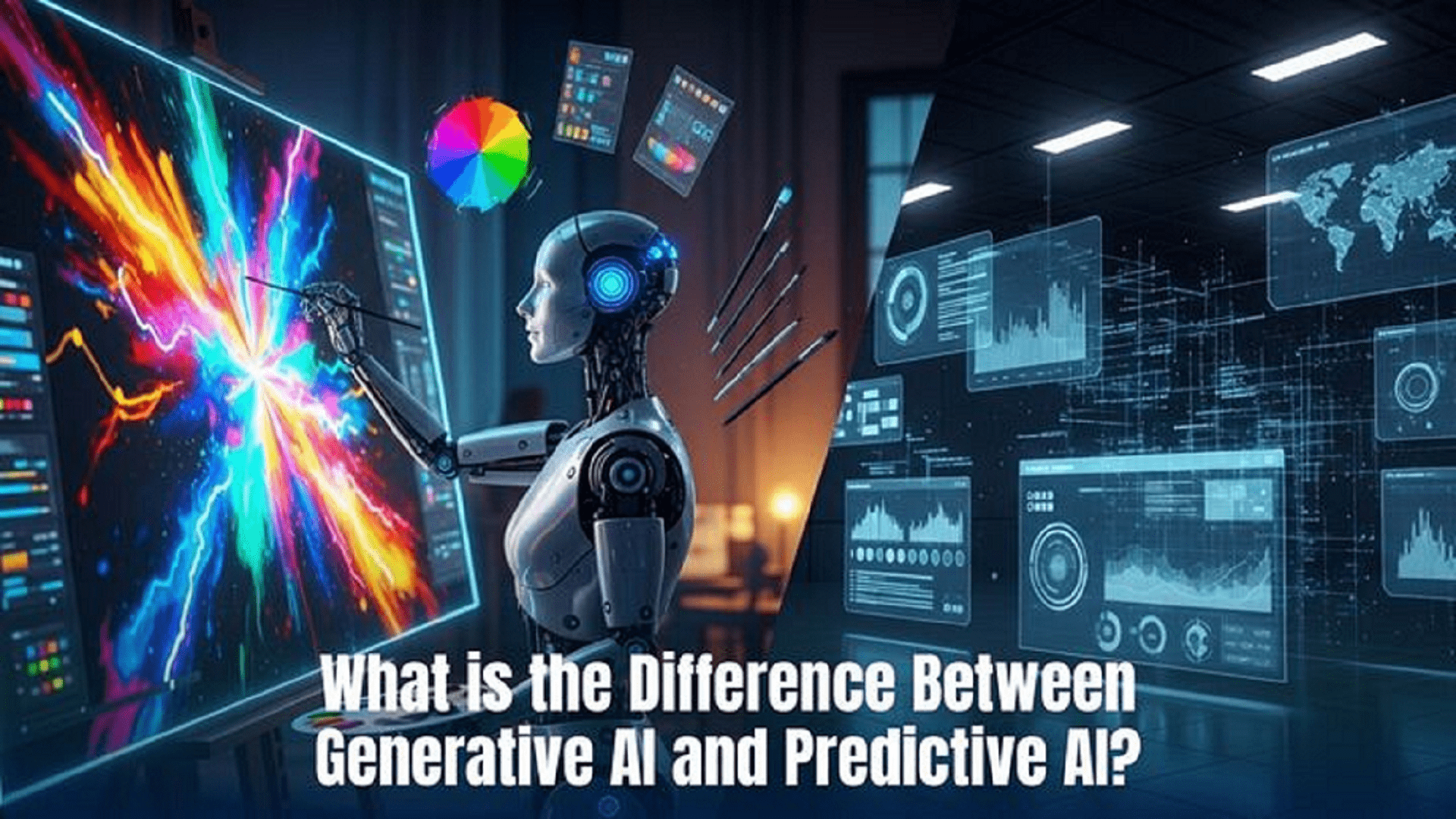Artificial Intelligence (AI) is changing how we live and work. It assists with many everyday things, such as voice assistants, chatbots, and apps. However, not all AI is the same. Two common types are Generative AI and Predictive AI.
Generative AI creates new items like text, pictures, or music. Predictive AI uses past and current data along with statistical methods and machine learning to find patterns and forecast future trends. This helps businesses plan, improve operations, and make smart choices.
This blog will explain the difference between Generative AI and Predictive AI in simple terms. You will learn how they work, what they do, and why they matter.
What is Generative AI?
Generative AI is a type of artificial intelligence that can create new things like text, images, music, videos, computer code, or designs. It stands apart from regular AI, which mainly analyzes data and provides answers or predictions. Generative AI takes it a step further. It learns from a large amount of data and then uses that knowledge to create something new that did not exist before.
Generative AI learns from existing data and produces new content based on patterns. It doesn’t just look at data; it generates fresh results.
For example:
- Chatbots that write stories or poems.
- Tools that design logos or websites.
- Apps that convert text into realistic images.
Popular tools like ChatGPT, DALL·E, and Midjourney are examples of Generative AI.
How Does It Work?
Generative AI uses smart systems like large language models (LLMs) or tools called GANs. These systems help the AI learn and create.
Here’s how it works:
- It looks at a large amount of data, like text, pictures, or videos.
- It learns patterns, styles, and how things are usually written or drawn.
- Then, it uses that learning to make something new that looks like it was made by a person.
For example, if you ask the tool to draw a cat wearing sunglasses, it will create a brand new picture. It does this by learning from thousands of cat images it has seen before.
What is Predictive AI?
Predictive AI, also known as predictive analytics, uses past and current data to predict future events. It combines artificial intelligence with statistical methods and machine learning to identify patterns in the data. This helps businesses understand what customers might want, improve their operations, and make informed decisions based on data.
Examples include:
- Netflix suggests shows you might like.
- Banks detect fraud by tracking patterns.
- Weather apps forecast rain or sunshine.
- E-commerce apps show products you may buy.
How Does It Work?
Predictive AI uses data analysis, machine learning, and algorithms to spot trends.
Here’s how:
- It takes historical data, like past purchases.
- It finds patterns and relationships.
- It predicts future behavior, such as your next likely purchase.
For example, if you often buy fitness gear, predictive AI might suggest new shoes or supplements.
Difference Between Generative AI and Predictive AI
Generative AI makes new content, while Predictive AI uses data, statistical algorithms, and machine learning to know future trends and support smart decisions.
Let’s now look at the main Difference Between Generative AI and Predictive AI through a comparison:
|
Feature |
Generative AI |
Predictive AI |
|
Purpose |
Creates new content |
Predicts future events |
|
Output |
Text, images, music, videos |
Numbers, trends, forecasts |
|
Data Use |
Learns and recreates styles |
Learns and predicts behavior |
|
Examples |
ChatGPT, DALL·E, GitHub Copilot |
Netflix recommendations, fraud alerts |
|
Main Tools |
LLMs, GANs |
Machine learning, regression, classification |
|
User Output |
Creative generation |
Data-driven decisions |
Generative AI Use Cases
Generative AI is very applicable in many industries:
- Marketing: Creating ad texts, social media posts, or product descriptions.
- Design: Automatically generating website Design, logos, or banners.
- Entertainment: Writing scripts, creating music, or generating game artwork.
- Education: Explaining concepts, creating study guides.
- Healthcare: Generating Fictional medical records for training or testing.
Predictive AI use cases
Predictive AI aids with decisions, planning:
- Finance: Calculating credit scores, preventing fraud, and predicting stock market trends.
- Retail: Predicting demand, customizing shopping offers.
- Healthcare: Predict disease risk, probability of patient readmission.
- Logistics: Predict delivery times or any delays.
- HR: Predict turnover or hiring needs.
Generative AI and Predictive AI: Which One Is Better?
Generative AI and Predictive AI are good and beneficial in their respective ways.
- If your need is content generation, use Generative AI.
- If your need is data prediction or reporting, use Predictive AI.
Many companies today use both forms of AI to provide outstanding services to their customers. An example would be:
- Predictive AI to suggest products.
- Generative AI to write product descriptions.
In that case, they work optimally together.
Challenges of Generative AI
Generative AI can be exciting, but there can also be some challenges:
- It can repeat the data it is trained on (copyright risk).
- That is bad because it is going to require significant computational power.
- It is recommended to review and verify a generative output before using it.
Predictive AI will also face challenges:
- The answer given is based on the past data quality being used.
- Give a worse answer if old data is being used because it will miss new patterns of behavior.
- It will be biased if there was a bias in the training.
That is why frequent updates and testing are recommended.
Conclusion
Understanding the Differences Between Generative AI and Predictive AI is crucial to be successful in the modern world. Generative AI allows an individual to create new things such as text, images, or music. Predictive AI looks at data to predict what will happen next. They are both helpful and serve different purposes.
The benefits can be beneficial if the two types of AI are used together. Whether you are a business owner, a student, a person who likes technology, or in the field, knowing the characteristics of what these AIs can do can help you gain a competitive edge.
FAQ's
Q1: What important values or risks should be considered when using Generative AI?
When using Generative AI, there can be issues of fake content, copyright issues, bias, and potential privacy risks, which means that caution and responsibility in your use of Generative AI are important.
Q2: What are some examples of Generative AI and Predictive AI?
Generative AI: ChatGPT (text), DALL·E (images), GitHub Copilot (code)
Predictive AI: Netflix recommendations, bank fraud warnings, weather predictions
Q3: How can you use Generative AI and Predictive AI to the benefit of your business?
Generative AI can help you generate content or designs, or code quickly; Predictive AI helps you forecast trends, understand customer behavior, and make informed decisions. They complement each other and help you be more efficient and grow.
Q4: Which Generative AI tools are highly favored by AI practitioners?
Some popular Generative AI tools are ChatGPT for text, DALL·E and Midjourney for images, GitHub Copilot for code, and Soundraw or Amper Music for music creation.
Q5: What are some examples of Predictive AI?
Examples of Predictive AI include: Netflix shows they think you'll like, fraud detection in banking, anticipating the weather, predicting sales, and analyzing customer behavior.
Q6: What are the benefits of Predictive AI and Generative AI?
- Predictive AI can forecast trends, enable better decision-making, reduce risk, and customize customer experiences.
- Generative AI can create content, allow for time-saving, enhance creativity, and assist in the faster development of text, images, code, and more.
-

Krishna Handge
WOWinfotech
Jul 28,2025
